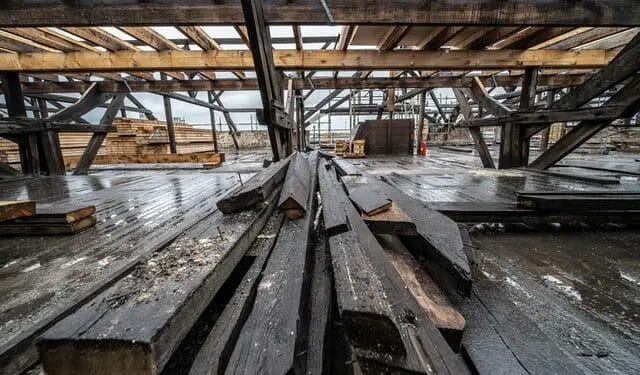When wood gets wet from rain, the drying time can vary depending on several factors. These include the type of wood, its thickness, and the weather conditions. Generally, smaller pieces of wood can dry within a few days, while larger logs may take several weeks or even months to fully dry. It’s important to ensure proper airflow and ventilation to facilitate the drying process and prevent the wood from rotting or developing mold. By allowing the wood to dry thoroughly, you can ensure its stability and durability for various projects.

The Importance of Drying Wood Properly
Properly drying wood is a crucial step in any woodworking project. Whether you’re building furniture, constructing a deck, or creating wooden crafts, ensuring that your wood is properly dried is essential for achieving a professional finish and preventing future problems. In this section, we will discuss the importance of drying wood properly and the potential issues that can arise if this step is overlooked.

1. Minimizes Shrinkage and Warping:
One of the primary reasons for properly drying wood is to minimize shrinkage and warping. Wood contains moisture, and when it is freshly cut, it has a high moisture content. As the wood dries, the moisture evaporates, causing the wood to shrink. If the drying process is not done correctly, the wood can shrink unevenly, leading to warping, twisting, and bowing. This can negatively impact the structural integrity and aesthetics of the final product.
By drying the wood properly, you allow it to release moisture evenly, minimizing the risk of shrinkage and warping. This ensures that the wood retains its shape and remains stable over time.
2. Prevents Mold and Fungal Growth:
Wood is a porous material that can easily absorb moisture from the surroundings. If wood is not dried properly, it can retain excess moisture, creating a favorable environment for mold and fungal growth. Mold and fungi thrive in damp conditions, and their presence can lead to structural decay, discoloration, and unpleasant odors.
Properly drying the wood helps eliminate excess moisture, making it less susceptible to mold and fungal growth. This not only preserves the quality and appearance of the wood but also ensures a healthier and safer environment.
3. Enhances Strength and Durability:
When wood is properly dried, it becomes stronger and more durable. The drying process allows the wood fibers to compact, resulting in increased density and hardness. This makes the wood less prone to damage, such as scratches, dents, and cracks.
Dried wood also has improved stability, as it is less likely to expand or contract with changes in humidity. This is particularly important for outdoor projects that are exposed to the elements, as improperly dried wood can quickly deteriorate and become structurally compromised.
4. Facilitates Finishing and Woodworking:
Properly dried wood is easier to work with and yields better results during the finishing process. When wood contains excess moisture, it can be challenging to achieve a smooth and even finish. The moisture content can interfere with the adhesion of paints, stains, and varnishes, leading to unsatisfactory results.
Drying the wood ensures that it reaches the optimal moisture equilibrium for the specific woodworking project. This allows for better absorption of finishes and improved adhesion, resulting in a professional-looking final product.
5. Saves Time and Money:
By properly drying your wood before starting a project, you can save both time and money in the long run. If wood is not adequately dried, problems such as shrinkage, warping, and mold growth can occur, requiring costly repairs or replacements.
Additionally, improperly dried wood may need to be reworked or may not meet your expectations, leading to wasted time and materials. Investing the necessary time and effort to dry your wood properly upfront can help you avoid these costly and frustrating issues.
Summary
Properly drying wood is essential for achieving professional-grade results and avoiding potential problems. It minimizes shrinkage and warping, prevents mold and fungal growth, enhances strength and durability, facilitates finishing and woodworking, and ultimately saves time and money. By understanding the importance of drying wood properly, you can ensure the success and longevity of your woodworking projects.

Factors Affecting the Drying Time of Wood after Rain
When wood gets wet after rain, it takes time for it to dry completely. The drying time can vary depending on several factors. In this section, we will explore the different factors that affect the drying time of wood after rain.
1. Type of Wood
The type of wood plays a significant role in determining the drying time. Hardwood, such as oak or maple, tends to take longer to dry compared to softwood, such as pine or spruce. This is because hardwood has a denser cellular structure, which restricts the movement of moisture and slows down the drying process.
2. Moisture Content
The initial moisture content of the wood also affects the drying time. Wood with a higher moisture content will take longer to dry compared to wood with lower moisture content. If the wood is already saturated with water, it will require more time for the moisture to evaporate and for the wood to reach its equilibrium moisture content.
3. Weather Conditions
The weather conditions play a crucial role in the drying process of wood. Factors such as temperature, humidity, and air circulation can significantly impact the drying time. Warmer and drier weather conditions promote faster evaporation of moisture from the wood, leading to quicker drying times. On the other hand, cold and humid conditions can prolong the drying process.
4. Wood Thickness
The thickness of the wood also affects the drying time. Thicker pieces of wood take longer to dry compared to thinner ones. This is because moisture needs to travel a longer distance to escape from the inner layers of the wood. Thicker pieces may also develop internal moisture gradients, which can further slow down the drying process.
5. Wood Orientation
The orientation of the wood can influence the drying time as well. Wood that is exposed to the sun and wind on all sides will dry faster compared to wood that is protected or shaded. Direct exposure to sunlight helps to speed up evaporation, while wind promotes better air circulation, aiding in the drying process.
6. Surface Area
The surface area of the wood also plays a role in drying time. Wood that has a larger surface area, such as rough-cut or textured wood, will dry faster compared to wood with a smaller surface area, such as wood that has been planed or sanded. The increased surface area allows for greater exposure to air, facilitating faster evaporation.
7. Treatment and Finishes
If the wood has been treated or finished with sealants or coatings, it may take longer to dry. These treatments can create a barrier that restricts the movement of moisture, slowing down the drying process. Additionally, certain finishes may require specific drying conditions, such as controlled humidity levels or extended curing times.
8. Air Circulation
Proper air circulation is essential for efficient drying of wood. If the wood is stacked or stored in a location with poor ventilation, it can impede the drying process. Ensuring adequate airflow around the wood helps to remove moisture and promote faster drying.
In summary, the drying time of wood after rain is influenced by various factors, including the type of wood, moisture content, weather conditions, wood thickness, wood orientation, surface area, treatment and finishes, and air circulation. Understanding these factors can help in estimating the drying time and taking appropriate measures to accelerate the process if needed.

Expert Tips for Accelerating the Drying Process of Wet Wood
When it comes to working with wet wood, drying it quickly is essential to ensure its usability and prevent decay. Wet wood not only affects the integrity of your projects but can also lead to mold and mildew growth. To help you accelerate the drying process of wet wood, we have compiled some expert tips that can save you time and effort.
1. Increase Air Circulation
One of the key factors in drying wet wood is increasing air circulation. By allowing more air to flow around the wood, you can enhance evaporation and speed up the drying process. Here are a few ways to improve air circulation:
- Stack the wood in a way that allows air to circulate freely between the pieces.
- Use fans or ventilators to create a constant breeze around the wood.
- Elevate the wood off the ground using pallets or blocks to promote airflow from underneath.
2. Apply Heat
Applying heat to wet wood can significantly expedite the drying process. Here are a few methods to consider:
- Use a heat gun or blow dryer to direct warm air onto the wet areas of the wood.
- Place the wood in a heated environment, such as a kiln or a heated drying room.
- Expose the wood to direct sunlight, as the heat from the sun can help evaporate the moisture.
3. Use a Dehumidifier
A dehumidifier can be a valuable tool in drying wet wood, particularly in enclosed spaces with high humidity levels. The dehumidifier will extract moisture from the air, aiding in the drying process. Make sure to monitor the humidity levels and adjust the dehumidifier accordingly.
4. Utilize Moisture Meters
Moisture meters are essential devices for accurately measuring the moisture content within the wood. By regularly checking the moisture levels, you can track the progress of the drying process and determine when the wood is sufficiently dry. This will help prevent any potential issues that may arise from using damp wood.
5. Maintain Proper Ventilation
Sufficient ventilation is crucial for drying wet wood effectively. Ensure that the drying area has proper ventilation to allow any evaporated moisture to escape. This will prevent the moisture from accumulating and prolonging the drying time.
6. Consider Using a Wood Dryer
If you frequently work with wet wood or need to dry large quantities, investing in a wood dryer can be a worthwhile option. Wood dryers provide controlled environments with optimal conditions for drying wood efficiently. These machines can significantly reduce drying times and ensure the wood is ready for use in a shorter period.
7. Allow Sufficient Time
While it may be tempting to rush the drying process, it is crucial to allow sufficient time for the wood to dry properly. The exact drying time will depend on various factors, such as the type of wood, thickness, and initial moisture content. By being patient and allowing the wood to dry naturally, you can ensure a more thorough and effective drying process.
8. Seal the Ends
Sealing the ends of the wood with a suitable sealer or wax can help minimize moisture loss through the ends and prevent cracking or splitting. This technique is particularly useful for drying logs or larger pieces of wood.
In summary, drying wet wood requires a combination of proper air circulation, heat, and patience. By following these expert tips, you can accelerate the drying process and ensure the wood is ready for your projects in a shorter period. Remember to prioritize safety when applying heat to wet wood and consult professionals if you are unsure about any techniques or methods.
Common Mistakes to Avoid When Drying Wood After Rain
After a heavy rainstorm, it is crucial to properly dry out any wood that may have been exposed to moisture. Failure to do so can result in damage to the wood, such as warping, cracking, or even rotting. To ensure that your wood dries effectively and maintains its quality, it is important to avoid these common mistakes:
1. Not Removing Excess Water
Before you begin the drying process, it is essential to remove any excess water from the wood. Leaving water on the surface can prolong the drying time and increase the risk of mold or mildew growth. Use a towel or sponge to carefully wipe off any visible water.
2. Storing Wood in an Enclosed Space
A common mistake is to store wet wood in an enclosed space, such as a garage or shed. While it may seem like a convenient solution, the lack of proper airflow can hinder the drying process. Instead, find an open area where air can circulate freely around the wood.
3. Applying Heat Directly
Using direct heat sources, such as heaters or blow dryers, to speed up the drying process can cause more harm than good. High temperatures can lead to uneven drying, which can result in warping or cracking of the wood. It is best to allow natural air circulation for gradual and even drying.
4. Neglecting to Rotate the Wood
When drying wood, it is important to regularly rotate the pieces to ensure that all sides are exposed to equal drying conditions. Neglecting this step can lead to uneven drying and potential warping. Take the time to flip the wood periodically to promote even moisture evaporation.
5. Rushing the Drying Process
Patience is key when drying wood. Rushing the process can result in subpar results and potentially damage the wood. Instead, allow sufficient time for the wood to dry naturally at its own pace. This will help maintain its structural integrity and reduce the risk of issues down the line.
6. Failing to Monitor Moisture Levels
Throughout the drying process, it is crucial to monitor the moisture levels of the wood. Using a moisture meter can help determine when the wood has reached an appropriate level of dryness. This step is essential to prevent prematurely removing the wood from the drying area.
7. Not Protecting the Wood During Drying
While the wood is drying, it is important to protect it from direct exposure to sunlight and harsh weather conditions. Direct sunlight can cause the wood to dry too quickly and unevenly, leading to potential damage. Consider using a tarp or covering to shield the wood from these elements.
8. Failing to Seal or Treat the Wood
Once the wood is fully dried, it is advisable to seal or treat it to protect against future moisture damage. Applying a wood sealer or finish will help maintain its quality and prolong its lifespan. This step is especially important for exterior wood that is exposed to the elements.
In summary, drying wood after rain requires careful attention to detail and proper techniques. By avoiding these common mistakes, you can ensure that your wood dries effectively and maintains its durability and aesthetics.
FAQs
How long does wood take to dry after rain?
The drying time of wood after rain depends on various factors such as the type of wood, thickness, temperature, humidity levels, and air circulation. In general, it can take anywhere from a few days to several weeks for wood to fully dry after being exposed to rain.
Conclusion:
In conclusion, the drying time of wood after rain depends on various factors. The type of wood, thickness, and weather conditions all play a role in the drying process. Hardwoods tend to dry slower than softwoods due to their denser nature. Additionally, thicker pieces of wood will take longer to dry compared to thinner ones. Weather conditions like humidity, temperature, and airflow can either speed up or slow down the drying time. It is essential to allow sufficient time for wood to dry completely before using it to prevent warping or decay. Proper storage and protection from rain can also help accelerate the drying process.
In summary, the drying time for wood after rain is variable and influenced by factors such as wood type, thickness, and weather conditions. It is crucial to be patient and allow adequate time for the wood to dry thoroughly to avoid potential issues like warping or decay. Proper storage and protection from rain can help expedite the drying process. By considering these factors and utilizing appropriate drying methods, you can ensure that the wood is ready for use in a timely manner.